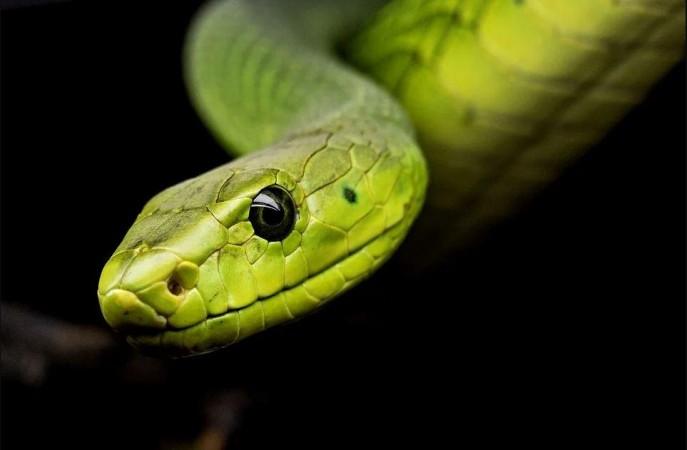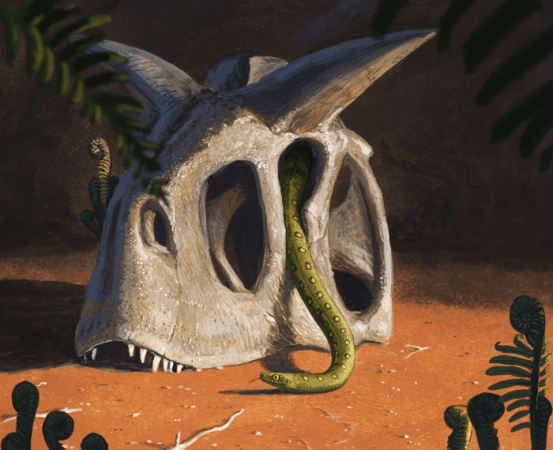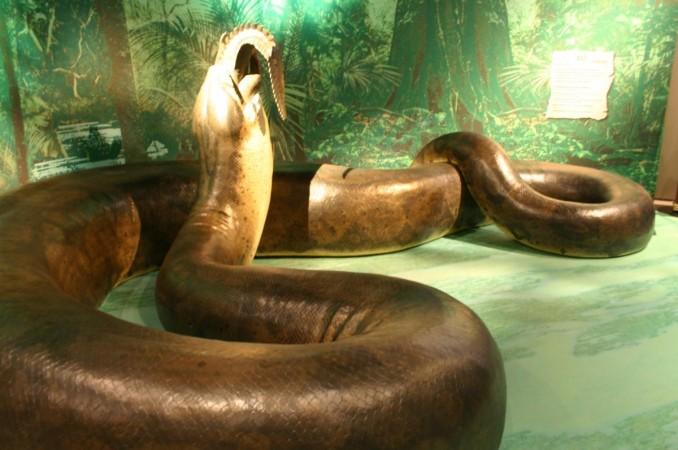Snakes are one of the most diverse groups of reptiles on Earth. From tiny harmless species such as the Brahminy blind snake to venomous cobras to giant bone-crushing anacondas, they come in varying sizes and degrees of lethality. Now, a new study states that all living snakes evolved from a small number of species that survived the massive asteroid impact that led to the extinction of dinosaurs and the majority of all living creatures at the end of the Cretaceous period.
According to an international team of researchers, modern snakes—comprising nearly 4,000 living species—began to diversify around the time of the Cretaceous–Paleogene (K–Pg) extinction event impact 66 million years ago. The authors state that the catastrophic event served as an opportunity for snakes to occupy places in the ecosystem that the older competitors previously held.
"Our research suggests that extinction acted as a form of 'creative destruction'- by wiping out old species, it allowed survivors to exploit the gaps in the ecosystem, experimenting with new lifestyles and habitats," said Dr. Nick Longrich, corresponding author of the study, in a statement. The findings of the research were published in the journal Nature Communications.
Reconstructing Evolution of Snakes

For the study, the team examined genetic variations between modern snakes in order to piece together the evolution of snakes. The phylogenetic analysis included 115 extant snake taxa. Additionally, two other sets of animals were scrutinized as additional reference points for the reconstruction.
The first was 44 non-snake squamates from all squamate (biggest order of reptiles constituting snakes, lizards, and worm lizards) clades. 10 non-squamate amniote (animals whose embryos develop within specific membranes), formed the second set. The researchers also analyzed fossils of snakes. This detailed examination facilitated the ascertaining of the period when modern snakes evolved.
According to their results, all living snakes can trace their evolutionary history back to a handful of species that managed to survive the asteroid impact that not only wiped out dinosaurs but also most of the other species of animals 66 million years ago.
Surviving and Diversifying

This raises a very important question—how did these species survive and diversify? The authors posit that the ability of snakes to seek shelter underground, and to survive without food for long periods, aided in their survival of the disastrous after-effects of the impact.
As a consequence of the event, their natural competitors such as other Cretaceous snakes and the dinosaurs became extinct. This permitted the surviving snakes to enter new niches in the food chain, new habitats, and into new continents.
Eventually, snakes began diversifying. New lineages such as boas, cobras, garter snakes, pythons, and vipers, which exploited the new habitat were produced, along with new prey. The scientists underlined that the diversity of modern snakes—including sea snakes, tree snakes, and poisonous cobras and vipers, and large constrictors such as pythons and boas—appeared only after the extinction of dinosaurs.
Change In Structure

Additionally, fossils also revealed that there was an alteration in the shape of snake vertebrae as a fallout of the event. This was a result of the extinction of competing Cretaceous lineages and the emergence of new groups which included colossal sea snakes such as Gigantophis that reached lengths of up to 10 m (33 ft), and land snakes such as Titanoboa that grew up to 12.8 m (42 ft) in length, during the Paleogene period (approximately 66 million years ago - 23 million years ago).
"It's remarkable, because not only are they surviving an extinction that wipes out so many other animals, but within a few million years they are innovating, using their habitats in new ways," highlighted Dr. Catherine Klein, lead author of the study.
Spreading Throughout the World
Another suggestion that the study made is that the spread of snakes across the world began around this time. Despite the likeliness of the ancestors of modern snakes living within the Southern Hemisphere, snakes appear to have first proliferated to Asia through those belonging to the clade Afrophidia, following the extinction.

"This seems to be a general feature of evolution - it's the periods immediately after major extinctions where we see evolution at its most wildly experimental and innovative. The destruction of biodiversity makes room for new things to emerge and colonize new landmasses. Ultimately life becomes even more diverse than before," noted Dr. Longrich.
Importantly, the research also uncovered evidence of second for a second major diversification event around the period when our planet's climate moved from a warm 'Greenhouse Earth' to a cold 'Icehouse' climate. It was during this time that the polar ice caps were formed and the Ice Ages began.
The authors emphasize that patterns witnessed in snakes point towards the crucial role of catastrophes— adverse, rapid, and global environmental disturbances—in steering evolutionary transformation.









!['Had denied Housefull franchise as they wanted me to wear a bikini': Tia Bajpai on turning down bold scripts [Exclusive]](https://data1.ibtimes.co.in/en/full/806605/had-denied-housefull-franchise-they-wanted-me-wear-bikini-tia-bajpai-turning-down-bold.png?w=220&h=138)



